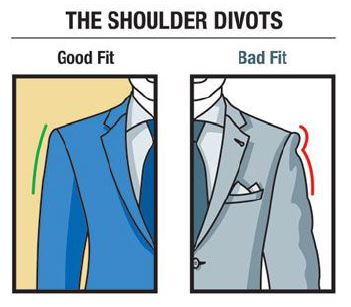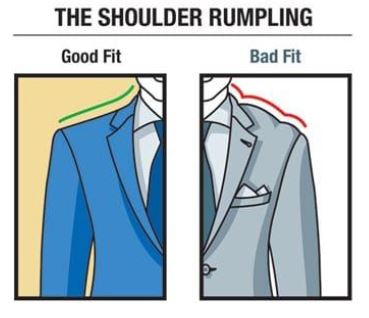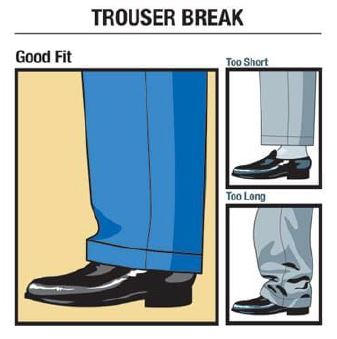The Suit Fitting Guide
Your guide to a stunning formal look
WHY FITTING
IS CRUCIAL…
Impeccable fabric selection for a suit, accessorizing done just right, but not enough attention given to how much your shirt’s cuff should peep out of your blazer, or if you would be better off with plain-fronted or pleated pants, could jeopardize your garment’s reputation. Simply put, an ill-fit would only mar your style, not make it. There’s something about a bespoke suit made to perfection, which accentuates your persona, and portrays you to the world in supreme elegance.
Let’s have a comprehensive look at the various elements of a gentleman’s attire and what are the different issues to be kept in mind while deciding for the perfect fit.
GETTING YOUR SHIRT RIGHT
Sartorially speaking, a shirt is undoubtedly a man’s most essential piece of clothing. And the first thing that strikes the eye when we look at a shirt is the fit, the way it drapes itself around a man’s torso and if he is pulling it off. Let’s take a quick look at these points to get your fit just right.
COLLAR: The two finger rule states that when you have your collar buttoned, you should be able to smoothly slide in two fingers. Any less and your collar would try to strangle you, more would hang around your neck like an oversized pet-collar.

Image Credits: www.realmenrealstyle.com

Image Credits: www.realmenrealstyle.com
SCYES: The scye seams should trace your shoulder curves. This makes the armholes neither too high that might hinder motion or too low to look sloppy.
SLEEVE LENGTH: Your sleeve’s length in a relaxed position should rest at a couple of centimetres beyond your wrist joint, that is the base of your palm, such that when you wear a suit jacket or blazer, about ⅜” of the cuff is visible.

Image Credits: www.realmenrealstyle.com

Image Credits: www.realmenrealstyle.com
SHIRT BOTTOM LENGTH: The length of your shirt should extend just beyond your belt when you raise your arms or place them behind your head. This ensures that it doesn’t come untucked with a bit of casual movement.
SUIT JACKETS AND BLAZERS
Power dressing is nothing without a suit and the power factor goes right outside the window if your suit doesn’t fit you right. There are several points to be kept in mind, missing any of which could spell disaster and a tastefully crafted suit could be your doom, should the fit go haywire.
Let’s take it from the top.
JACKET COLLAR: The collar of your jacket wraps closely around the shirt collar. The right fit shows somewhere between ½” – ¾” of the shirt’s collar above the jacket collar. A size too big causes the infamous “collar gap” to appear, where the jacket/blazer and the shirt are sans contact around the neck. Pay special attention to the fact that even though the collar may fit correctly around the shirt, fabric bunching or “collar roll” (a lump of fabric right below the collar) may appear at the back of the neck, if the fit is a bit too tight. The easiest way to prevent this from happening is to sit down and check yourself in the mirror. The elusive bunching occurs the most in this posture.

Image Credits: www.realmenrealstyle.com

Image Credits: www.realmenrealstyle.com
SHOULDERS: The seam along the length of your shoulders must sit exactly above them. If the armhole goes beyond the the shoulder curve, it would be loose and hence, droop down. Likewise, if the seam stays within the shoulder, the jacket will start pulling at the chest, making it uncomfortable to wear and to look at.
SHOULDER DIVOTS: Contrary to popular belief, shoulder divots (the little protruding fabric at the corner of the shoulder) are not caused by either a wide shoulder cut or extra padding along the shoulder line. The reason behind this abomination is that the sleeve cap is not in conformity with the shape of the wearer’s body. Make sure that the sleeve cap’s height and width matches that of your armhole.

Image Credits: www.realmenrealstyle.com

Image Credits: www.realmenrealstyle.com
SHOULDER RUMPLING: We prevented divots, but the shoulders can have yet another fit issue. If you end up with some bunching at the shoulder line, you’re looking at what’s called shoulder rumpling. It’s actually a simple issue, your shoulders might not be broad enough as the cloth above. This means the jacket has extra interior space, getting a smaller size easily fixes this.
JACKET CLOSURE: In a two-button suit jacket or blazer, the narrowest part of your waist should be where the first button is, which is where the blazer has the least width. During a test fit, in a standing position, check if the front is hanging baggily after fastening the top button. This indicates a loose fit. Conversely, if you notice any wrinkles beside the lapels or by your waist, then your jacket is a size too short. The jacket should hug you just enough, so you don’t feel suffocated by it.
If your jacket has a single button, fasten it and check your fit as mentioned above. Similarly, fasten the middle button for a three button jacket.
PS: To prevent a major faux pas, avoid fastening the second button on your jacket.

Image Credits: www.realmenrealstyle.com

Image Credits: www.realmenrealstyle.com
JACKET SLEEVE LENGTH: The jacket sleeve should NEVER cover the entire length of the shirt sleeve. Nor should it be so short as to have the whole of the shirt cuff poking out. This would mean that the jacket is too tight to be fitting you anywhere properly. Show half an inch of the shirt’s cuff, that’s the age-old rule and though there’s a little wiggle room to it, but not by much.
SLEEVE PITCH: In a standard rest state, the sleeve should be aligned with the contours of your arm. In case of a construction defect, even though the sleeve appears wrinkle-free on a mannequin, it will form spirals on your upper arm, obstructing the smooth flow of the fabric.

Image Credits: www.realmenrealstyle.com

Image Credits: www.realmenrealstyle.com
JACKET LENGTH: There are three simple ways to determine the appropriate jacket length, use whichever method you find most convenient. First, the back panel should ideally end where your derrière starts to curve back in. Second, the hem of your jacket/blazer should meet somewhere at the junction of your fingers when you have your hand curled up in your palm, in a standard resting position. Third, the length of the jacket should be more or less, half the distance starting from the base of your shirt collar to the bottom of your foot.
TROUSERS – THE SALT TO YOUR SUIT
Sagging trousers along with a full trouser break, together are a recipe for destruction. You might wonder why, because trousers are generally not the first thing one would focus on. And that exactly is their purpose. Complement the suit, or the shirt, making a gradual transition southwards, instead of becoming a stark, noticeable change.
THE SEAT: A well-fitted pair of trousers shall do away with the need to wear a belt. The trousers would drape along the thighs such that you should be able to pull the cloth away from your skin by just about an inch. Any lesser would lead to the formation of hideous horizontal pleats beneath your seat. The only thing worse than that, will be pants that sag about the length of your leg, giving a very laid-back, sluggish appearance.

Image Credits: www.realmenrealstyle.com

Image Credits: www.realmenrealstyle.com
TROUSER BREAK: Trouser break refers to the area where your trousers would fold at the conjunction point with your shoe, where the shoe ‘breaks’ the fall of your pants. This has been increasingly becoming a matter of personal preference as to how much cloth you want to have wrinkled by your ankle, if any at all.
TROUSER BREAKS: While considering dress pants or trousers, the best and safest path is to go for a slight/quarter to medium/half break. This means that you would have either half a fold or one fold where your trousers touch your shoe.
No break is the situation where the hem of your trousers would barely skim the shoe. This style runs the risk of showing ankles or socks while standing and definitely while sitting. So, unless you wish to showcase the dragon tattoo on your ankle, let’s not opt for a no break in a formal setting. There’s only one plus side to this, it gives an illusion of height for shorter guys, then again, it’s better if chosen for a more casual occasion.
Full break is when you can see a significant number of folds around your shoe. Now, that’s a huge red flag. It’s not a long shot from making it appear like you forgot an appointment with the tailor. Also, you might just trip over yourself should the fabric go under the shoe’s heel. A pair of denims offer more leeway with a full break, since the cloth is thick enough to not wrinkle ungraciously.



Image Credits: www.realmenrealstyle.com

Image Credits: www.realmenrealstyle.com
POCKET FLARES OR POCKET EARS: A slim fitting pant would tend to have these. When the pants fit too tightly around the upper thighs, the fabric near the pockets starts to fluff up and becomes unsightly. In a perfect fit, the pants shall lie flat everywhere with no show of any extra cloth. Since stitching a pair lying flat on a table is different from putting them on, letting-out the pants here, fixes the problem.
WRINKLING UNDER THE FRONT WAISTBAND: The presence of a slight bulge around the belly, tries to push the pants down, leading to wrinkling just below the belt. So, if you know your body tends to retain water, it’s better to have the trousers’ waistband tightened a little, to prevent the occurrence of these pleats.

Image Credits: www.realmenrealstyle.com
GET THE PERFECT FIT RIGHT AT YOUR DOORSTEP.
Thanks for paying us a visit. We are looking forward to seeing more of you soon. For more, feel free to get in touch with us on any of our contact points.
Happy Dressing!
